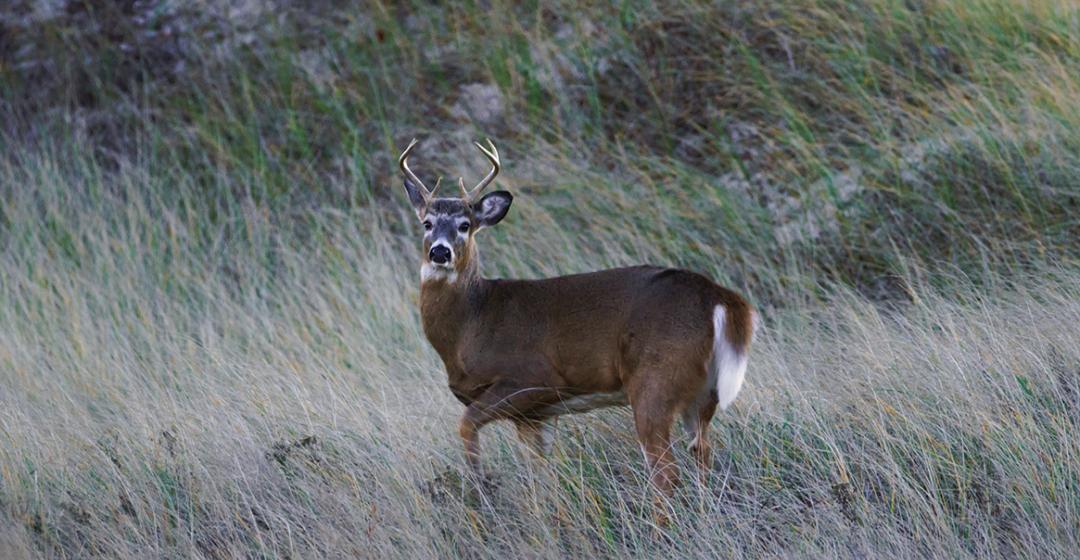As cool nights refresh lingering summer days and tinges of color appear across the Martha’s Vineyard landscape, Island deer hunters are looking forward to the start of the 2022 archery hunting season on the first Monday in October. Non-hunters have good reason to take an interest in their success.
The whitetail deer is a critical link in the life cycle of the deer tick, which feeds and breeds on deer. State wildlife managers peg the Island’s deer density at more than four times the target level of twelve to eighteen deer per square mile. More deer equals more ticks. That adds up to one of the country’s highest rates of tick-borne disease. And there is another public health wrinkle: evidence of Covid infection has been found in deer across the United States and Canada, including on the Island.
During the 2021 December gun hunting seasons, state and federal biologists tested 558 deer in Massachusetts for SARS-CoV-2 antibodies and active virus as part of a national surveillance program in twenty-eight states. Massachusetts Division of Fisheries and Wildlife (DFW) deer biologist Martin Feehan said eighty-six deer, including fourteen of twenty-six deer in Dukes County, tested positive for Covid antibodies. The Delta variant was detected as the active variant in the state. In contrast, surveillance of deer in New York conducted predominantly in January turned up the Omicron variant.
“It’s very clear that the variants that are showing up with deer are tracking whatever the dominant variant is in the human population at the same time,” Feehan said.
Public health officials said the findings do not pose an immediate threat to humans or deer. Feehan said there is no evidence of any risk to hunters, and per the DFW website, “there have been no known cases of humans contracting Covid-19 from deer.”
Whitetail deer have it very good on Martha’s Vineyard. And why not? The Island provides dense cover for shelter and an ample natural food supply, supplemented by a buffet of ornamental landscaping and gardens.
Plus, there are no natural predators. DFW relies on hunters to keep the deer herd in check. But despite beginning two weeks earlier, last year’s Island harvest was the lowest since the 2015 season.
Throughout the 2021 archery, shotgun, and primitive weapon seasons – twelve weeks in all – deer hunters on the Island harvested 667 deer. The year prior, they took 922 animals. In 2019, hunters took a record 1,119 deer. “The 28 percent drop on Martha’s Vineyard is particularly concerning as it will likely lead to an acceleration in deer population growth,” Feehan said.
About the harvest decline, Feehan said an abundance of acorns “likely impacted the visibility of deer as they spent less time moving to look for food.
“But it’s clear,” he added, “that the pandemic was the driving factor.”
He said the East Coast saw a drop of about 10 percent in deer harvest numbers, which he attributed to the end of pandemic restrictions. Members of the hunting community were focused on resuming activities, he said, and had less time for hunting.
On the Vineyard, an influx of new residents staying year-round may have affected housing availability for off-Island hunters who spent fewer days hunting than they had historically during shotgun season. Property owners who did not allow hunting, normally absent during hunting season, also could have contributed to the decline.
Deer do not require a great deal of property to survive. In rural areas, the standard home range for a doe is around two to three square miles. But in urban areas, it can be well under half a square mile. “And so they can essentially spend their entire life in a handful of blocks,” he said. “So, if you have properties that are closed to hunting, then you create a bunch of mini-refuges where those deer can’t be accessed, and they don’t need to go anywhere else because their home ranges are so small.”
Deer density equals tick density. That is particularly true concerning the lone star tick, a relatively recent and aggressive arrival from the southeastern states. Once found mainly in Aquinnah, Chilmark, and on Chappaquiddick, the lone star is now turning up across the Island.
The lone star is responsible for alpha-gal syndrome, an allergic reaction to mammalian products, including red meat, dairy products, and some medications. “It’s a life-changing allergy,” said Patrick Roden-Reynolds, a public health biologist working in collaboration with the Vineyard and Nantucket boards of health on tick-borne disease education and prevention. Roden-Reynolds said he found two lone star ticks this summer during a home yard survey in a Vineyard Haven residential district “with neighbors on both sides and a paved road right in front of the yard.” He expects lone stars to continue to become more common.
An illustration of how deer can impact tick density occurred this summer. Roden-Reynolds responded to a call from a down-Island homeowner who said that a doe had died in his yard after being struck by a vehicle. The animal had only been dead for about three hours when he arrived. “And by the time I got there, there were [lone star] ticks crawling on the logs next to the dead deer,” Roden-Reynolds said. “There were still at least 150 ticks, both nymphs and adults, crawling on its ears and back of the neck. And I saw some fully engorged females that had dropped off. And, you know, those are the ones that are going to be laying eggs.”
Roden-Reynolds told the property owner: “You should really think about spraying that direct area.”





